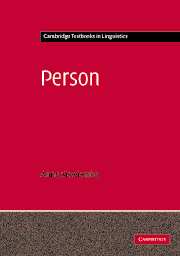Book contents
- Frontmatter
- Contents
- List of figures
- List of tables
- Preface
- List of abbreviations
- 1 Introduction
- 2 The typology of person forms
- 3 The structure of person paradigms
- 4 Person agreement
- 5 The function of person forms
- 6 Person forms and social deixis
- 7 Person forms in a diachronic perspective
- Appendix 1 List of languages in the sample by macro-area
- Appendix 2 Genetic classification of languages cited in the text
- References
- Author index
- Language index
- Subject index
5 - The function of person forms
Published online by Cambridge University Press: 05 June 2012
- Frontmatter
- Contents
- List of figures
- List of tables
- Preface
- List of abbreviations
- 1 Introduction
- 2 The typology of person forms
- 3 The structure of person paradigms
- 4 Person agreement
- 5 The function of person forms
- 6 Person forms and social deixis
- 7 Person forms in a diachronic perspective
- Appendix 1 List of languages in the sample by macro-area
- Appendix 2 Genetic classification of languages cited in the text
- References
- Author index
- Language index
- Subject index
Summary
Since person forms are referential expressions, all accounts of their function are based on their distinctiveness relative to other referential expressions. This distinctiveness is seen to lie in their minimal semantic content and attenuated phonological form. In the traditional literature these two characteristics are said to make of person markers convenient substitutes for NPs and thus useful devices for avoiding repetition, redundancy and achieving brevity and clarity of expression. A number of more sophisticated interpretations of the function of person forms have been developed by scholars working in various theoretical frameworks, such as Centering Theory (e.g. Grosz, Weinstein & Joshi 1995), Discourse Representation Theory (e.g. Kamp & Reyle 1993), Neo-Gricean Pragmatic Theory (e.g. Huang 2000) and cognitively oriented discourse analysis (e.g. Ariel 1990; Cornish 1999; Givón 1990; Gundel Hedberg and Zacharski 1993). As it is impossible to give even a brief account of these various approaches here, I will concentrate on one, namely on cognitive discourse analysis.
Section 5.1 will outline the general approach to referential expressions adopted within cognitive discourse analysis and in particular the assumed relationship between the cognitive status of discourse referents in the memory store of the addressee and morpho-syntactic encoding, briefly mentioned in chapter 2 (section 2.2.1.2). In the context of this relationship, person forms emerge as markers of referents which exhibit mid-high to high accessibility.
- Type
- Chapter
- Information
- Person , pp. 173 - 213Publisher: Cambridge University PressPrint publication year: 2004



